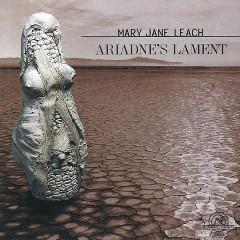Mary Jane Leach – Ariadne's Lament (1998)
Mary Jane Leach – Ariadne's Lament (1998)

1 O Magna Vasti Creta 9:16 2 Call Of The Dance 9:57 3 Windjammer 10:12 4 Tricky Pan 9:33 5 Ariadne's Lament 8:12 6 Song Of Sorrows 7:59 New York Treble Singers Arlene Travis (soprano) Cassatt String Quartet: Jennifer Leshnower, Muneko Otani - violin Michiko Oshima - viola Kelley Mikkelsen - cello The Rooke Chapel Choir David Lee Echelard (countertenor) Libby Van Cleve (oboe) Patrick Burton (clarinet) Klyph Johnson (bassoon) Virginia Davidson (conductor) William Payn (conductor)
The music of Mary Jane Leach on this album draws on several sources of inspiration. The first is early music, with its polyphony and modal harmonies. Modal writing, as adapted to twentieth-century thought, focuses on the prolongation of a fixed collection of notes, arranged into either a traditional or an invented scale. Melodies and harmonies are created freely from this collection, without forcing them into highly directional and strongly articulated phrases. The result is a luxurious stasis, with poles of attraction-pitches that serve as points of repose-strongly stated. From modal antecedents, Leach dervices her own unexpected twists and innovations.
The influence of early music is evident in other ways. Like those of the Renaissance, Leach's scores are free of dynamic and expressive markings. Two of the pieces draw their musical material directly from Renaissance works: Ariadne's Lament from Monteverdi, and Tricky Pan from the fourteenth-century poet and composer Solage. The languages Leach sets-early Italian and French, ancient Greek and Cretan-also evoke a sense of connection to a remote past.
In her early compositional work, Leach experimented with recording individual lines on 8-track tape and then accompanying herself. This enabled her to be musically self-sufficient, and also allowed for more intricate textures than she could create with a single-line instrument. Tricky Pan, for solo countertenor and tape, is modeled directly on this technique. Gradually, as her music began to be more widely sought after by ensembles, Leach's fascination with multiple tracks led her to adapt it to live players: The choral pieces on this album all divide the chorus into eight independent parts.
While there is a substantial body of twentieth-century music that delights in the chimerical and the quickly transformed, Leach's music is from the esthetic which favors prolongation, resonance, long statements of subtly varied persistence. In that sense, her music is both easy to follow and mellifluously unpredictable. She has a careful ear for pacing and structural unfolding, often building her pieces to ardent, expressive arrivals. The traditional distinction between consonance, as pillars of stability, and dissonance-unstable moments that must inevitably seek out resolution-is maintained, though she will allow dissonances to flower and persist in ways her predecessors did not. ---Anthony K. Brandt, mjleach.com
download (mp3 @320 kbs):
yandex mediafire ulozto gett bay files








